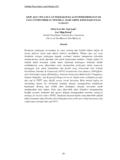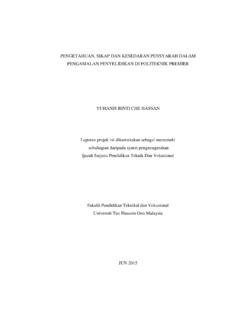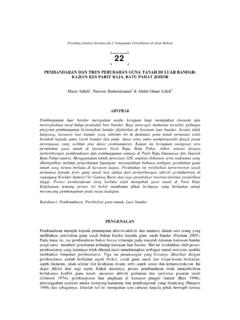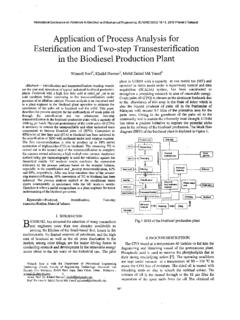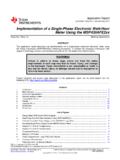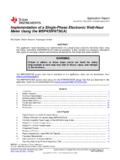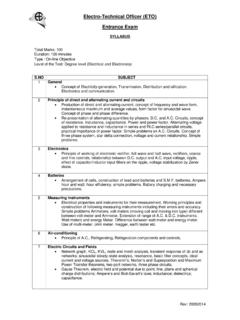Transcription of MODELING OF THREE PHASE INVERTER FOR PHOTOVOLTAIC ...
1 I MODELING OF THREE PHASE INVERTER FOR PHOTOVOLTAIC APPLICATION PHILIPS DHARMARAJ A project report submitted in partial fulfillment of the requirement for the award of the Master of Electrical Engineering Faculty of Electrical and Electronic Engineering Universiti Tun Hussein Onn Malaysia JULY, 2012 v ABSTRACT A THREE - PHASE INVERTER for PHOTOVOLTAIC application is developed and simulated using MATLAB/Simulink software. By assuming the PV module is ideal at all weather condition, a basic dc source is used as input for the DC-DC closed loop step up converter. A pulse generator takes the role of an MPPT. The switching frequency is in the range of 500 MHz to 1 GHz at various duty cycles.
2 This output is then used to switch IGBT INVERTER at 120 conduction mode. PWM Generator is used to generate pulses for carrier-based two-level pulse width modulator (PWM) in bridge converter. This block generates pulses for carrier-based pulse width modulation (PWM) converters using two-level topology. The block can be used to fire the forced-commutated devices THREE - PHASE bridges. The modulation index is set at , while the frequency is set in rad/sec. The sampling time is in the range of microseconds. The performance of the system is then further analyzed and proven by calculating the load current, inductance, impedance, load power, PHASE voltage and line voltage. vi ABSTRAK Sebuah penyonsang tiga-fasa untuk kegunaan tenaga solar telah dibangunkan dan disimulasi menggunakan perisian MATLAB/Simulink.
3 Dengan mengandaikan modul tenaga solar yang digunakan adalah unggul, maka sebuah bekalan kuasa arus terus yang paling asas digunakan sebagai sumber kuasa masukan untuk membentuk sebuah litar gelung tertutup arus terus-arus terus. Sebuah penjana isyarat juga digunakan untuk menggantikan peranan penjejak titik kuasa maksimum. Frekuensi pensuian adalah diantara 500 MHz to 1 GHz pada pelbagai kitar kerja. Keluaran peringkat ini seterusnya digunakan untuk pensuisan sebuah penyonsang IGBT yang berkonduksi pada 120 . Penjana modulasi lebar denyut pula digunakan untuk menjana denyut pembawa dua-tahap pada pengubah tetimbang. Blok ini menjana denyut terhadap modulasi lebar denyut berasaskan denyut pembawa.
4 Blok ini juga boleh digunakan untuk memicu peranti tetimbang tiga-fasa. Indeks modulasi boleh ditetapkan pada , manakala frekuensinya ditetapkan dalam rad/saat. Masa persampelan adalah dalam jurang mikrosaat. Kemampuan system ini seterusnya dinilai dan dianalisa dengan menghitung arus beban, aruhan, galangan, kuasa beban, voltan fasa dan voltan talian. vi CONTENTS TITLE i DECLARATION ii DEDICATION iii ACKNOWLEDGEMENT
5 V ABSTRACT v CONTENTS vi LIST OF TABLES ix LIST OF FIGURES xi LIST OF SYMBOLS AND ABBEEVIATIONS xii CHAPTER 1 INTRODUCTION 1 Background of Study 1 Project Background 2 Project objectives 4 Project scope 4 CHAPTER 2 LITERATURE REVIEW 5 vii Introduction 5 General Characteristics of PV Inverters 7 Inverters for Grid-connected Systems 7 Line-commutated 9
6 Self-commutated 9 Voltage source inverters 9 Current source inverters 10 Switch Mode INVERTER 10 Converters 13 DC-DC converter 14 General overview of DC-DC converter 14 2 DC-DC converter switching 16 Boost converter 19 Boost converter overview 19 Switch open analysis 22 CHAPTER 3 METHODOLOGY 28 Boost Converter 28 Boost Converter Operation in Continuous Conduction
7 Mode 29 Boost Converter Operating in Discontinuous Conduction Mode 31 Design Considerations for Boost Converter 32 THREE - PHASE bridge inverters 34 Two switches conducting 34 Sinusoidal pulse-width modulation 36 PWM Generator 37 Generator block 38 Frequency of output voltage 39 PHASE of output voltage 39 Dialog Box and Parameters 39 CHAPTER 4 RESULT & ANALYSIS viii Boost Converter 41 Mode 1 operation of the Boost Converter 42 Mode 2 operation of the Boost Converter 42 THREE PHASE INVERTER
8 43 THREE - PHASE INVERTER Simulation 46 Mathematical Analysis 49 CHAPTER 5 CONCLUSIONS AND FUTURE WORKS 52 Conclusions and recommendations 52 REFERENCES 53 ix LIST OF TABLES Advantages and disadvantages of photovoltaics 6 Classifications of converters 14 Device conduction mode 34 Switching sequencing and line-to-line voltage output 43 x LIST OF FIGURES Conventional Power System 1 The PV from cell to module 5 Block diagram of a grid-connected PHOTOVOLTAIC generator 7
9 Principle of connecting PV systems to the grid with a single- PHASE and THREE - PHASE INVERTER 8 Half-bridge configuration 11 xi Full-bridge configuration 11 Two-level output waveform of half-bridge configuration 12 THREE -level output waveform of full-bridge configuration 12 Basic converter system 13 Two converters are used in a multistep process 13 General DC-DC converter block diagram 15 Switching of DC-DC converter 16 Switching pulse 17 Continuous Conduction Mode 18 Discontinuous
10 Conduction Mode 18 Inductor curr

